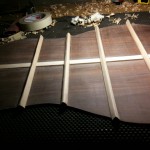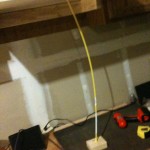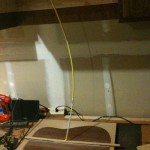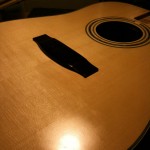Ok, the studio is back up and transmitting. That just means I have stopped stuffing my mouth with Halloween candy long enough for me to make another post.
Epoxy. Or should I say Z-poxy.
Let’s start at the beginning.
Wood CAN be very poreous. If you look at some of the closeup pictures in my other posts, you can get an illustration. From what I understand, if you finish a guitar without filling those pores (or gaps) then you end up with a guitar with a bad complexion. What happens is that the finish gets sprayed on, you sand it, and the wood sucks in (or absorbs) the finish and the finish then gets sucked into the pours. That is a theory that I think I read somewhere…. I could be totally full of crap, though.
Enter Z-poxy. Z-poxy is an epoxy finishing resin. Most epoxies are for adhering things to one another. This epoxy is for finishing. Basically, you just apply the epoxy to the wood and it fills the pores… simple as that. Simple, yes! Messy? very.
I use gloves to apply the stuff. If it gets on your hands you’ll be using sandpaper to get it off after it dries.
The first few pictures are my first attempt at pore filling the back of the guitar and the headpiece. A lesson learned on this application is that the more you leave on the back, the more you will have to sand off. So my next attempts consisted of applying the epoxy and then scraping off the excess. For the back, I used an old Subway (eat fresh!) card. The subsequent applications were used with some clay modeling utensils.
You see all that epoxy globbed on there? It took me soooo long to sand that off, even with an electric sander.
You can see the epoxy reflections in the pores of the wood here.

From what I have read, 3 applications of the epoxy should be enough. Epoxy, sand, epoxy, sand, epoxy, sand, done.
On to finishing the rest of the guitar.
-Marcus

























































